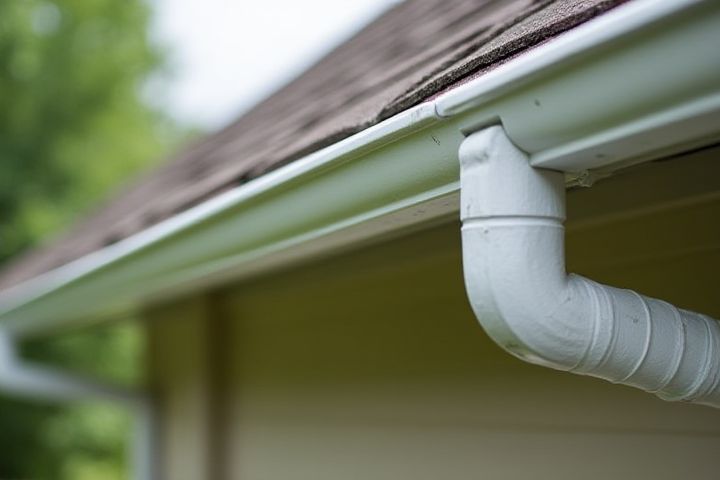
To maintain house gutters effectively, regular cleaning is essential to prevent clogs from leaves, twigs, and debris. Use a sturdy ladder and gloves for safety, ensuring you clean gutters every six months or after significant storms. Inspect the downspouts for blockages, ensuring water flows freely away from your foundation. Check for signs of rust or damage to the gutters, as any deterioration can lead to leaks and water damage to your home. Consider installing gutter guards for added protection and ease of maintenance, helping to keep your system functioning efficiently year-round.
How To Maintain House Gutters
Regular cleaning
Regular cleaning of house gutters is essential to prevent clogs and water damage, ideally twice a year in spring and fall. Accumulated leaves, twigs, and debris can lead to overflow, causing mold and foundation issues. Using a sturdy ladder and gloves, remove debris by hand or with a trowel, ensuring that downspouts are also clear for optimal water flow. Consider investing in gutter guards or screens to minimize future buildup, increasing the longevity of your home's drainage system.
Inspect for damage
Regularly inspecting your house gutters for damage is crucial for effective maintenance. Look for signs of cracks, rust, or separation from the roofline, which can indicate wear and tear. Ensure that downspouts are clear and direct water away from your foundation; improper drainage can lead to costly repairs. By checking your gutters at least twice a year, especially before and after heavy rainfall, you can prevent water damage and extend the lifespan of your gutter system.
Check for leaks
To maintain your house gutters, regularly inspect them for leaks, which can compromise their function and cause water damage. Look for visible cracks or holes, and test for leaks by running water through the gutter system after a rain or with a hose. If you find any leaks, use a sealant designed for gutters to seal the affected areas; this will prevent water from escaping. Ensuring your gutters are leak-free will help protect your home's foundation and landscape from water erosion and potential structural damage.
Ensure proper slope
To ensure proper slope in your house gutters, aim for a minimum slope of 1/4 inch for every 10 feet of gutter run. This gradual incline helps facilitate the efficient flow of rainwater towards downspouts. Regularly check your gutters for blockages or debris that could disrupt this slope and lead to water pooling. You may also consider installing adjustable hangers to fine-tune the pitch, ensuring effective drainage all year round.
Install gutter guards
Installing gutter guards is essential for maintaining the efficiency of your house gutters. Gutter guards prevent debris, leaves, and other materials from clogging the gutters, allowing water to flow freely and protecting your home from potential water damage. When selecting gutter guards, consider options like mesh screens, solid guards, or reverse curve designs, as each offers unique benefits for different environments. Regularly inspecting your gutter guards for buildup and ensuring they are properly affixed will help prolong their effectiveness and enhance your home's drainage system.
Trim nearby trees
Trimming nearby trees is essential for maintaining house gutters, as overhanging branches can deposit leaves, twigs, and debris that clog the system. Regularly inspect the area around your home to identify trees that are too close to your roofline, and prune their branches at least three feet away from your gutters. This not only minimizes blockages but also helps prevent water damage by ensuring proper water flow away from your home. Schedule tree trimming at least twice a year, particularly during fall and spring, to keep your gutters functioning efficiently.
Secure gutter firmly
To effectively secure your gutter systems, first, ensure that all mounting brackets are tightly fastened, typically every two feet along the gutter length. Regularly inspect for any rust or corrosion on brackets and replace them as needed to prevent gutter sagging. Using high-quality screws instead of nails can enhance stability and longevity, which is crucial for upholding a proper drainage system. For added security, consider adjusting the pitch of your gutters to the recommended slope of 1/4 inch for every 10 feet to ensure optimal water flow and prevent clogs.
Clean downspouts
Cleaning downspouts is crucial for maintaining functional house gutters. Begin by using a plumber's snake or a high-pressure water nozzle to dislodge any clogs, which can accumulate due to leaves and debris. It's essential to check that water flows freely through the downspouts; any obstruction can cause water overflow, leading to potential damage to your home's foundation. Inspect and clean your downspouts at least twice a year, ideally in spring and fall, to ensure optimal water flow and prevent costly repairs.
Inspect fascia and soffit
Regular inspections of your fascia and soffit are crucial for effective gutter maintenance. Look for signs of water damage, such as discoloration or peeling paint, which may indicate that your gutters are not directing water away effectively. Check for any cracks or sagging in the fascia board; these could jeopardize the integrity of your roofing structure. Keeping your fascia and soffit in good condition not only enhances the appearance of your home but also prevents costly repairs down the line.
Use a stabilizing tool
Using a stabilizing tool enhances your safety and efficiency while maintaining house gutters. Invest in a sturdy extension ladder equipped with stabilizing bars, which secure the ladder against the roof and prevent wobbling. Regularly inspect gutters for debris, ensuring proper drainage, as clogged gutters can lead to structural damage costing homeowners up to $5,000 in repairs. Consider cleaning your gutters at least twice a year, ideally in spring and fall, to keep them in optimal condition and extend their lifespan.
